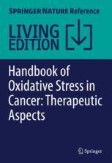Search
Search Results
-
HSP27 Modulates Neuropathic Pain by Inhibiting P2X3 Degradation
The role of heat shock protein 27 (HSP27), a chaperone, in neuropathic pain after nerve injury has not been systematically surveyed despite its...

-
The miR-15b-Smurf2-HSP27 axis promotes pulmonary fibrosis
BackgroundHeat shock protein 27 (HSP27) is overexpressed during pulmonary fibrosis (PF) and exacerbates PF; however, the upregulation of HSP27 during...

-
Heat Shock Protein HSP27 and the Status of the Glutathione System in Dexamethasone-Induced Apoptosis of Jurkat Tumor Cells
We studied the effect of the HSP27 inhibitor, 5-(5-ethyl-2-hydroxy-4-methoxyphenyl)-4-(4-methoxyphenyl)-isoxazole, at a final concentration of 0.1 μM...
-
Activation of the HSP27-AKT axis contributes to gefitinib resistance in non-small cell lung cancer cells independent of EGFR mutations
PurposeAlthough epidermal growth factor receptor (EGFR)-activating mutations in non-small cell lung cancer (NSCLC) usually show sensitivity to...

-
Cluster analyses of the TCGA and a TMA dataset using the coexpression of HSP27 and CRYAB improves alignment with clinical-pathological parameters of breast cancer and suggests different epichaperome influences for each sHSP
Our cluster analysis of the Cancer Genome Atlas for co-expression of HSP27 and CRYAB in breast cancer patients identified three patient groups based...

-
HSP27 role in cardioprotection by modulating chemotherapeutic doxorubicin-induced cell death
The common phenomenon expected from any anti-cancer drug in use is to kill the cancer cells without any side effects to non-malignant cells....

-
Small Heat Shock Proteins HSP10 and HSP27 in the Left Ventricular Myocardium in Rats with Arterial Hypertension and Insulin-Dependent Diabetes Mellitus
We studied the expression of small heat shock proteins HSP10 and HSP27 in left ventricular cardiomyocytes in animals with arterial hypertension,...
-
Heat shock protein 27 in the pathogenesis of COVID-19 and non-COVID acute respiratory distress syndrome
Acute respiratory distress syndrome (ARDS) is a common cause of hypoxemic respiratory failure in intensive care units that has increased dramatically...

-
Heat shock protein 27 deficiency promotes ferrous ion absorption and enhances acyl-Coenzyme A synthetase long-chain family member 4 stability to promote glioblastoma cell ferroptosis
BackgroundGlioblastoma is one of the malignant tumors of the central nervous system with high lethality, high disability and low survival rate....

-
Tacrolimus reverses pemphigus vulgaris serum-induced depletion of desmoglein in HaCaT cells via inhibition of heat shock protein 27 phosphorylation
BackgroundGlucocorticoids are the first-line treatment for Pemphigus vulgaris (PV), but its serious side effects can be life-threatening for PV...

-
Elucidation of Possible Role of Heat Shock Protein as Potent Therapeutic Agent in ROS-Mediated Cancer and Its Assessment Through Computational Biology Methods
In several therapeutic studies related to cancer, tumor cell differentiation, invasion, proliferation, and metastasis, heat shock proteins (HSPs)...
-
Elucidation of Possible Role of Heat Shock Protein as Potent Therapeutic Agent in ROS-Mediated Cancer and Its Assessment Through Computational Biology Methods
In several therapeutic studies related to cancer, tumor cell differentiation, invasion, proliferation, and metastasis, heat shock proteins (HSPs)...
-
The radiation- and chemo-sensitizing capacity of diclofenac can be predicted by a decreased lactate metabolism and stress response
BackgroundAn enhanced aerobic glycolysis (“Warburg effect”) associated with an increase in lactic acid in the tumor microenvironment contributes to...

-
Resveratrol and siRNA in combination reduces Hsp27 expression and induces caspase-3 activity in human glioblastoma cells
GBM cells can easily gain resistance to conventional therapy, and therefore treatment of glioblastoma multiforme (GBM) is difficult. One of the...

-
Geranylgeranylacetone attenuates cerebral ischemia–reperfusion injury in rats through the augmentation of HSP 27 phosphorylation: a preliminary study
BackgroundWe previously reported that heat shock protein 27 (HSP27) phosphorylation plays an important role in the activation of glucose-6-phosphate...

-
Elevation of major constitutive heat shock proteins is heat shock factor independent and essential for establishment and growth of Lgl loss and Yorkie gain-mediated tumors in Drosophila
Cancer cells generally overexpress heat shock proteins (Hsps), the major components of cellular stress response, to overcome and survive the diverse...

-
Serum levels of anti-heat shock protein 27 antibodies in patients with chronic liver disease
Heat shock protein 27 (HSP27), an intracellular molecular chaperone, is involved in the pathogenesis of cancer by promoting both tumor cell...

-
PROGRESS STUDY: Progression of chronic kidney disease in children and heat shock proteins
Various molecular and cellular processes are involved in renal fibrosis, such as oxidative stress, inflammation, endothelial cell injury, and...

-
Muscular HSP70 content is higher in elderly compared to young, but is normalized after 12 weeks of strength training
PurposeAging is associated with increased myocellular stress and loss of muscle mass and function. Heat shock proteins (HSPs) are upregulated during...

